| HOME |
|---|

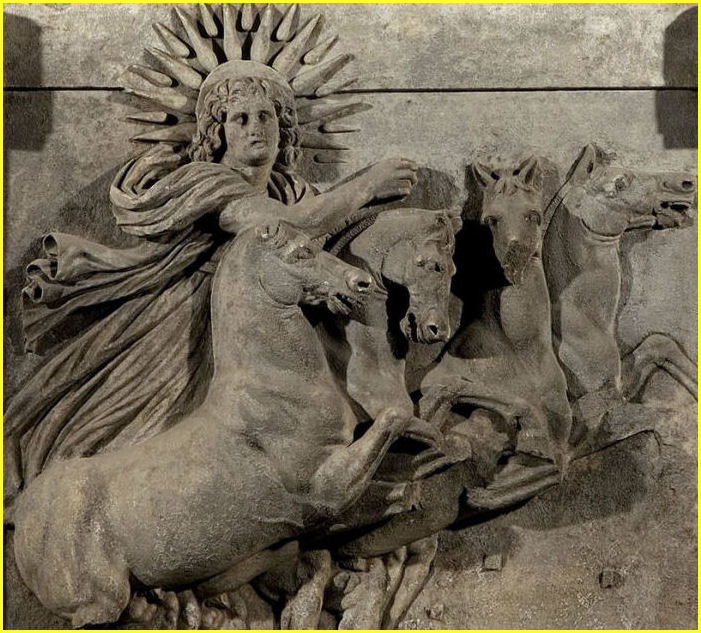
Relief of Helios - Temple of Athena - 420 BC
| HOME |
|---|


The Greeks knew him as Helios, god of the Sun. To the Romans he was Sol, and every morning he drove his four horse chariot up out of the eastern ocean into the sky, galloping westward through the day, his blazing crown lighting up the world. At day's end he disappeared down into the western sea, through the night returning eastward beneath the waves, to do it all over again the next morning.
The ancients regarded all the major players in the solar system as gods or goddesses, but there is surely none more deserving of divine status than the all powerful, life giving Sun at the centre of it all. It literally holds our solar system together, its light and warmth making it possible for the biology of life to arise and evolve and endure. Without Sol, there would be no solar system, no Earth, and no us.
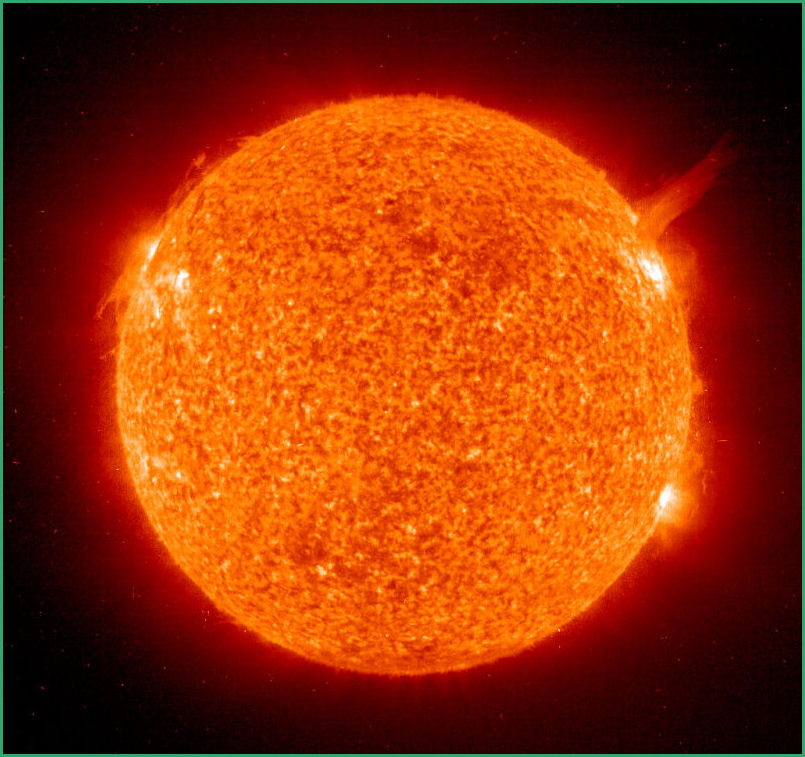
| Current Solar Flare (X-ray) activity : |
|
| Current Solar Geomagnetic Field status: |
|
| Updated every ten minutes from the NOAA Space Environment Center. | |
Our Sun is a star, just like all the other stars in the sky, and it began life slowly, as all stars do. In the relative vacuum of space, microscopic particles have a tendency to congregate, and over long enough periods of time they can generate huge clouds of gas and dust, like the Great Orion Nebula, and it is inside these clouds that stars are born.
When portions of these clouds become dense enough, the force of gravity comes into play, consolidating the particles into a thick disk rotating around a gravitational centre. Eventually, the centre of this disk becomes so dense that particles collide, creating friction, which generates heat, and it begins to warm up. This process can continue for millions or billions of years, until the centre of the disk becomes so dense and so hot that single electron hydrogen atoms are forced to fuse together into double electron helium atoms, a process known as nuclear fusion, the same process involved with hydrogen bombs. This powerful energy pushes outward, and begins to counteract the inward pull of gravity. When nuclear fusion is strong enough to slow the inward energy of gravity, a precarious balance is reached between these powerful forces - and a star is born.
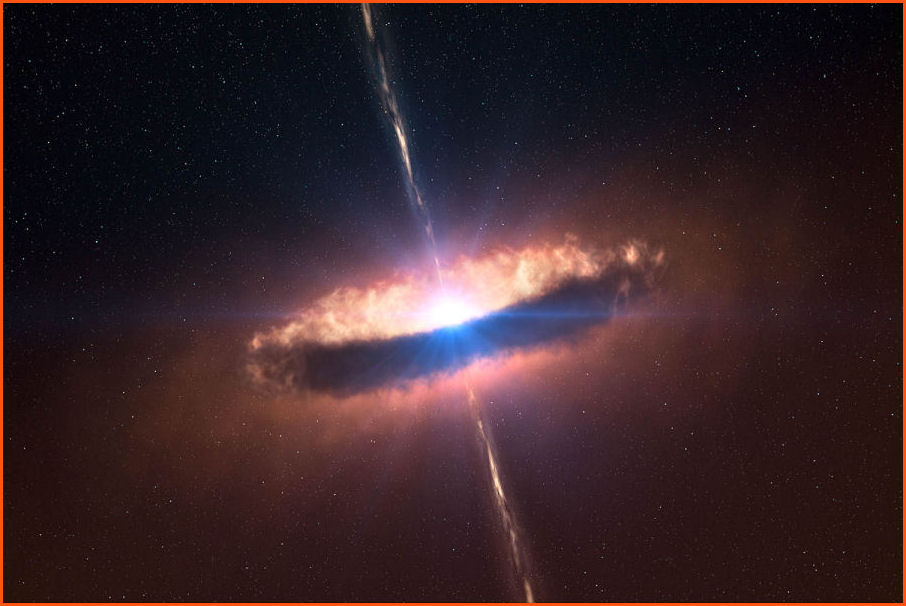
For many millions or even billions of years, depending on the size of the star, it happily burns away as a main sequence star, fusing hydrogen into helium, like millions of nuclear bombs going off simultaneously, over and over. But sooner or later the supply of hydrogen begins to run out, and the star begins to die. For our Sun, this will happen in about five billion years from now. It will slowly cool and redden in color. And as the outward pressure produced by fusion lessens, gravity begins to get the upper hand again, and the star will begin to contract. What happens next depends on the size of the star.
When a small or average star like our Sun begins to die, there is not enough gravity to hold on to its cooler, outer layers, and while its core compresses, its outer layers expand outwards, and the star grows in size dramatically, entering the red giant phase of its life. Eventually the outer layers dissipate, leaving behind the very small, but still very hot core of the star, and it is now known as a white dwarf. With no fuel to sustain it, the white dwarf slowly cools and fades, but it takes a very long time to do so. And its extreme density means that its gravity is still a mighty force to be reckoned with, and can have a profound effect on objects in its vicinity. 97% of all the stars in the Universe, including our Sun, will end their lives in this manner.
When stars more than 8 times the mass of our Sun begin to die, and contract, the amount of material being pulled into their core is too much to handle. The core becomes so hot and so dense, hydrogen and helium atoms are fused into more complex elements such as carbon, oxygen, nitrogen, magnesium, copper, gold and lead. Finally, the core of the star is compressed to the point that it ends its life in the mother of all explosions - a supernova. This explosion is so powerful it produces more light than an entire galaxy of billions of stars, and can be seen millions of light years. away. What is left after the explosion is a small, super dense, rapidly spinning remnant called a neutron star, or pulsar, surrounded by an expanding halo of gas and dust containing all the new complex elements formed by the dying star, seeding the cosmos with the building blocks of life. For this is where all the complex elements in the universe come from - the explosive death of a super massive star. All the complex atoms that make up all the planets and moons and rocks and trees and you and me, were made inside a super massive star.
Below is a photo of the Crab Nebula in the constellation Taurus. It is the cloud of heavy molecules produced by a supernova that exploded almost a thousand years ago. At its centre spins a Pulsar, one of the most powerful energy sources in the Universe.
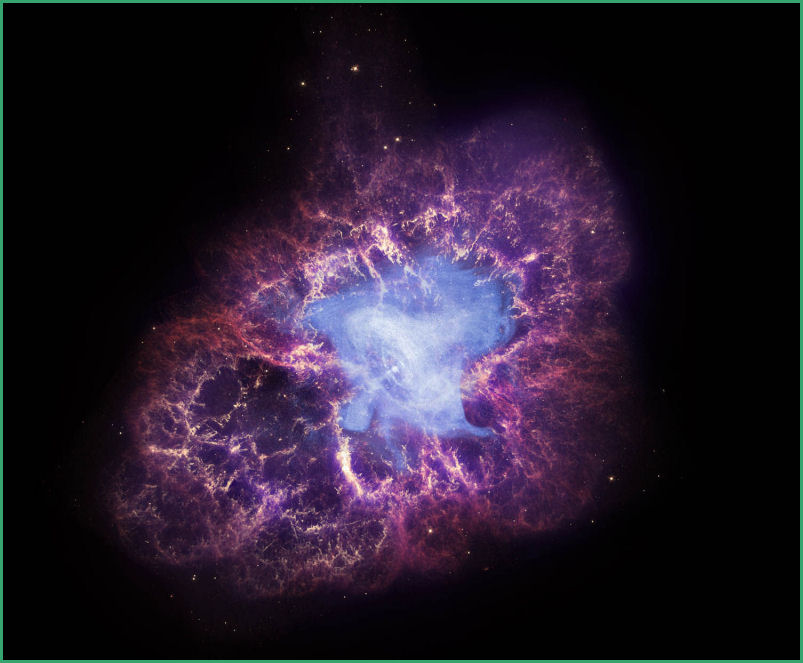
Occasionally a star is so massive that when it uses up its fuel and begins to collapse, the heat and pressure in its core are so great they transcend the very laws of physics, and something extraordinary happens. It disappears. Now you see it, now you don't. The extreme density in its core creates a gravitational field so intense that nothing within a certain distance (called the event horizon) can escape, including the fastest thing in the Universe: light. All that is left of this super giant star is a black hole in space, where not even light can live. Appropriately enough, this magical entity is called a Black Hole. They are invisible, and they are the most powerful known objects in the Universe. Powerful enough to pull in stars thousands of light years away. Powerful enough to build galaxies, containing hundreds of billions of stars. We now know that virtually all galaxies have a black hole at their center. Below is a NASA diagram showing the wildly spinning vortices and energy fields surrounding a Black Hole.
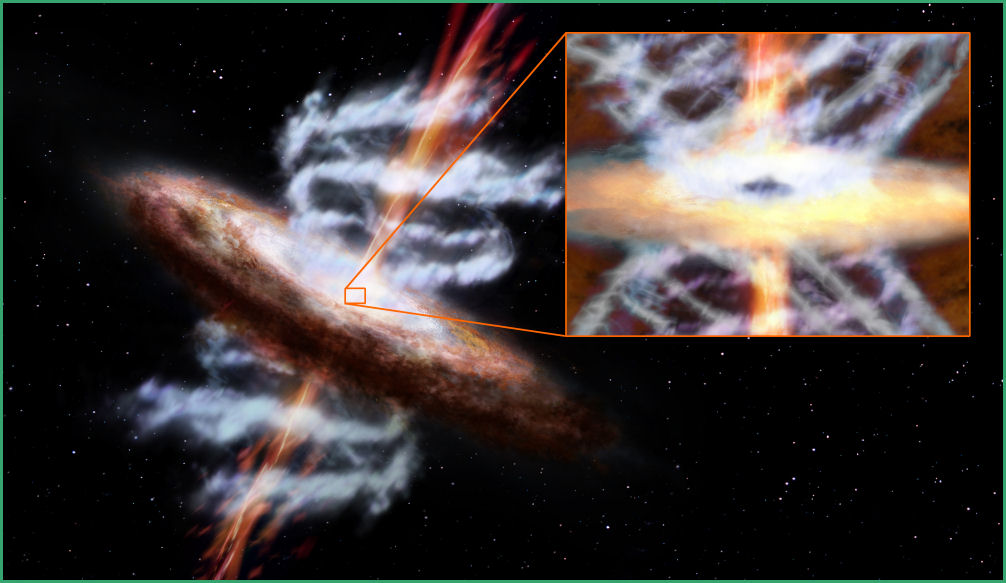
Everything we know about a star is learned from the detailed analysis of its spectrum, or more simply its colour. Every star produces a unique spectrum, as individual as a fingerprint, from which modern technology is able to glean a great deal of information, and that is no small thing. Stars are the engines that run the Cosmos. The more we know about stars, the more we know about the Cosmos. And the more we know about the Cosmos, the more we ultimately know about ourselves.
The basic classification of stars is illustrated by the H-R diagram/graph below, named for the two astronomers, Hertzsprung and Russell, who designed it. The graph is divided into seven lettered "spectral classes" according to colour. Each spectral class is divided into ten numbered subclasses, which further define the shade of colour. Following the spectral designation, a Roman numeral specifies the size of the star.
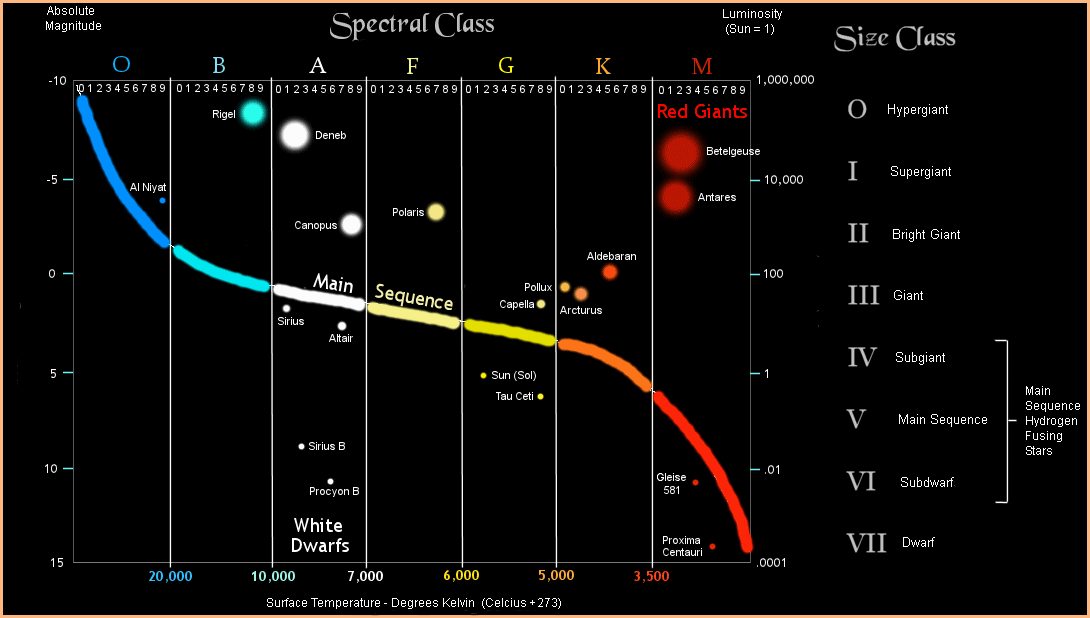
Unless otherwise specified, star temperatures are surface temperatures, measured in degrees Kelvin. This is the scientific temperature scale which bottoms out at the theoretical temperature of absolute zero, the lowest temperature possible, at which all molecular motion would cease. This corresponds to -273.15 degrees Celcius (Centigrade), or -459.67 degrees Fahrenheit. When dealing with the temperatures of stars however, involving thousands and tens of thousands of degrees, the differences between the scales become insignificant.
Our Sun is a G2V yellow main sequence star, with a surface temperature of almost 6,000 degrees K. A star with a spectral class of G3 would be a slightly darker yellow, and a slightly cooler temperature. A star on the main sequence path is a "living star" in the prime of its life, happily fusing hydrogen to helium in its core. When its core hydrogen runs out it becomes a "dying star", expanding into a giant that ultimately either explodes its outer layers away (if it's large enough) or simply sheds them, becoming a small, dense remnant of itself called a dwarf. Confusingly, main sequence stars are also often referred to as dwarfs.
Our Sun is one million miles in diameter. A million Earths could fit inside it, with room to spare. It is 93 million miles away from us, a distance also known as one astronomical unit (AU), one more tool to try and make sense of the vast distances in space. The Sun is so far away that its light - traveling 186,000 miles per second, takes a full eight minutes to reach us.
But the Sun's light only takes three minutes to travel to its closest planet, the little scorched world of Mercury, our next stop...
|
|
|
| SOL | MERCURY | VENUS | EARTH | METEORS | MOON | MARS | ASTEROIDS | JUPITER | SATURN | URANUS | NEPTUNE | PLUTO | COMETS |
|
|
|